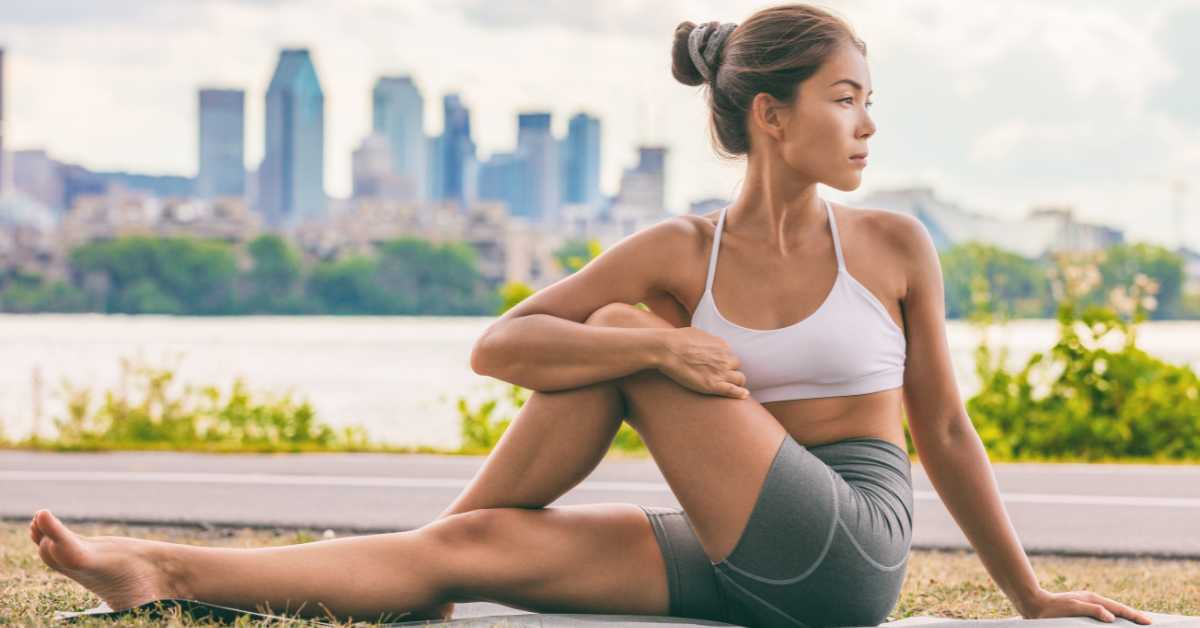Stop letting stiff muscles slow you down! As we age, our bodies naturally tighten up, making everyday movements harder and increasing the risk of injury. But you don’t have to accept feeling stiff and sluggish. Stretching isn’t just important—it’s non-negotiable if you want to stay strong, flexible, and injury-free.
And it’s not just your body that benefits. Stretching is a powerful stress-buster, melting away tension and leaving you feeling calm, focused, and ready to take on the day. Don’t let age define how you move or feel—take control! Discover these 7 daily stretches that will transform your body and mind, keeping you sharp, limber, and energized.
Stretches You Should Do Every Day – List
Neck Tilt
A good neck stretching exercise is the neck tilt stretch. To do this stretch:
- Stand or sit upright with your shoulders relaxed.
- Slowly tilt your head to one side, bringing your ear towards your shoulder.
- Hold the stretch for about 10-15 seconds.
- Slowly return to the starting position.
- Repeat on the other side.
You should aim to do this stretch on both sides of your neck for a total of 3-4 repetitions.
Stretching neck benefits
Stretching your neck muscles can help improve flexibility and range of motion, which can help reduce the risk of injury and improve overall physical function. It can also help to relieve muscle tension and stiffness, which can help reduce the risk of headaches and other muscle-related pains.
Shoulder Roll
A good shoulder stretching exercise is the shoulder roll stretch. To do this stretch:
- Stand or sit upright with your shoulders relaxed.
- Slowly roll your shoulders forward in a circular motion, bringing them towards your chest.
- Hold the stretch for about 10-15 seconds.
- Slowly return to the starting position.
- Repeat the stretch in the opposite direction, rolling your shoulders backward in a circular motion.
You should aim to do this stretch in both directions for a total of 3-4 repetitions.
Stretching shoulder benefits
One of the main benefits of stretching your shoulder muscles is that it can increase flexibility and range of motion in the shoulders. This can help reduce the risk of injury and improve your overall physical function. Additionally, stretching can also help to relieve muscle tension and stiffness, which can help prevent headaches and other muscle-related pains.
Doorway Chest Stretch
Consider this simple chest stretch exercise, the doorway chest stretch. To do this stretch:
- Stand in a doorway with your arms out to the sides, palms on the doorframe.
- Step forward with one foot and lean your body into the doorway, feeling the stretch in your chest.
- Hold the stretch for about 10-15 seconds.
- Slowly return to the starting position.
You should aim to do this stretch 3-4 times.
Stretching chest benefits
It is important to stretch your chest muscles because they can become tight and shortened from activities such as sitting at a desk or driving for long periods of time, or from activities that require repetitive arm movements. This can lead to poor posture, muscle imbalances, and a decrease in range of motion. Stretching the chest muscles can help to alleviate these issues and improve overall flexibility and mobility.
Sitting Hamstring Stretch
A hamstring stretch exercise is a simple and effective way to stretch the muscles in the back of your thighs. To do this stretch:
- Sit on the floor with your legs extended in front of you.
- Reach towards your toes on one leg, keeping the other leg bent with the foot touching your inner thigh.
- Hold the stretch for about 10-15 seconds.
- Slowly return to the starting position.
- Repeat the stretch on the other leg.
You should aim to do this stretch on both legs for a total of 3-4 repetitions.
Stretching hamstring benefits
By stretching your hamstring muscles regularly, you can help improve your flexibility and range of motion, reduce the risk of injury, and prevent back pain. Tight hamstring muscles can make it difficult to bend your knees or move your legs freely, which can affect your overall mobility and physical function. It can put extra strain on the muscles and joints in your lower back, which can increase the risk of pain and discomfort.
Standing Calves Stretch
A calf stretch exercise is a great way to stretch and strengthen the muscles in your lower leg. One variation of this stretch is the standing calf stretch. To do this stretch:
- Stand facing a wall with your hands on the wall at shoulder height.
- Step back with one leg, keeping the heel of your front foot on the ground.
- Bend your front knee and lean your body towards the wall, feeling the stretch in the back of your calf.
- Hold the stretch for about 10-15 seconds.
- Slowly return to the starting position.
- Repeat on the other leg.
You should aim to do this stretch on both legs for a total of 3-4 repetitions.
Stretching calves benefits
By stretching your calf muscles, you can improve your flexibility and range of motion in your lower legs, thereby reducing your risk of injury and improving your overall fitness. Additionally, stretching your calf muscles can reduce muscle tension and stiffness, which can reduce the risk of muscle cramps and pains.
Aside from its physical benefits, stretching your calf muscles can also boost your mental health. By stretching, you can reduce stress and tension, and feel more relaxed and calm
Quadriceps Stretch
A quadriceps stretch is a simple and effective way to stretch the muscles in the front of your thighs. To do this stretch:
- Stand upright and hold on to a stable surface for balance, if needed.
- Bend one leg and grab your foot behind you, pulling it towards your buttocks.
- Hold the stretch for about 10-15 seconds.
- Slowly return to the starting position.
- Repeat on the other leg.
You should aim to do this stretch on both legs for a total of 3-4 repetitions.
Stretching quadriceps benefits
It is important to stretch your quadriceps muscles as they can become tight and shortened from sitting for long periods of time, engaging in activities that involve repetitive leg movements, or not stretching regularly. Tight quadriceps muscles can lead to a number of problems such as muscle imbalance, reduced range of motion, and poor posture.
Supine Spinal Twist
Here’s a lower back stretch, the supine spinal twist. To do this stretch:
- Lie on your back with your knees bent and your feet flat on the floor.
- Bring your knees up to your chest and cross one leg over the other.
- Gently let your legs fall to one side, keeping your shoulders on the floor.
- Hold the stretch for about 10-15 seconds.
- Slowly return to the starting position.
- Repeat on the other side.
You should aim to do this stretch on both sides of your lower back for a total of 3-4 repetitions.
Stretching lower back benefits
Poor posture, sitting for long periods of time, and lifting heavy objects can cause your lower back muscles to become tight and tense. Having tight lower back muscles can lead to discomfort and pain, poor posture, and reduced flexibility and range of motion.
Your lower back muscles can be stretched to improve flexibility and range of motion, which can make reaching, bending, and lifting easier. In addition to relieving tension and stiffness in the lower back muscles, stretching can also help reduce the risk of headaches.

Claudia Faucher is a full-time fitness training expert and lifestyle blogger. She is also been a certified Les Mills BodyPump instructor for the past 5 years and a fitness instructor for over 20 years. Claudia is a personal trainer and creates fitness training programs for seniors and people of all ages. She likes to use her skills and experiences to help others on their fitness journeys.
